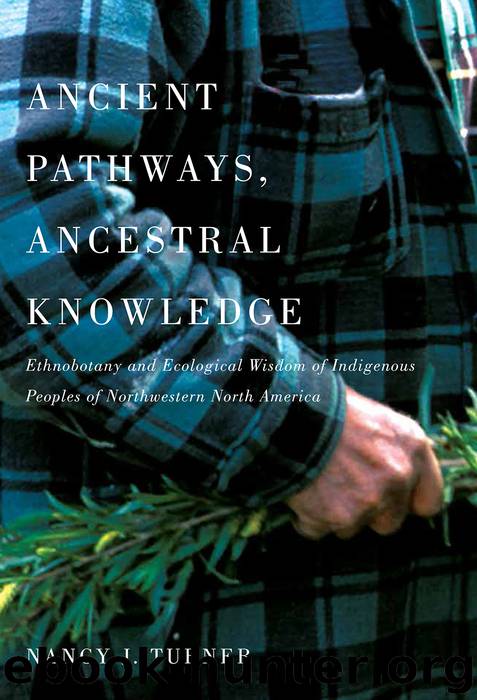Ancient Pathways, Ancestral Knowledge by Nancy Turner

Author:Nancy Turner
Language: eng
Format: epub
ISBN: 9780773585409
Publisher: MQUP
Note: The groups for which this information was available were also selected to be representative of peoples from the northern coast (Haida) and southern coast (Saanich) and from the northern interior (Gitxsan, Upriver dialect) and southern interior (Secwepemc).
Sources: For Haida, see de Vries (2012); for Saanich, see Claxton and Elliott (1993); for Gitxsan, see Wale (n.d.), as sourced by Leslie Main Johnson (pers. comm., 2011); and for Secwepemc, see R.E. Ignace (2008).
At the mouth of the Nass River, at Fishery Bay, while people were staying at the oulachen camp and rendering the grease, they also harvested large quantities of the rootstocks of spiny wood fern. Traditionally people pit-cooked these root vegetables or else steamed them on the stovetop until they were soft. Once they were cooked, the “fingers” (leaf bases of previous years’ fronds) were peeled and mixed with oulachen grease and sugar. One Nisga’a elder recalled, “We used to get ax (wood fern roots) too … You get it right off the ground, and you have to boil that, and you peel the skin off [from the “fingers” and the core] and that’s really good. You mix it with grease and sugar … Get them by the sack. It’s used for dessert; mix it with new [oulachen] grease and sugar, that’s all. It’s sort of a delicacy” (Wilp Wilxo’oskwhl Nisga’a 1995, 83).
In relatively quick succession, over the course of the spring, there was more clam digging and other shellfish harvesting, and people also travelled to their estuarine root gardens to dig quantities of silverweed, clover, riceroot, and other root vegetables, before these plants started to sprout and grow their leaves. The succulent shoots of giant horsetail, thimbleberry, salmonberry, and cow-parsnip also appeared at this time and were harvested – in some cases by the armful – to be eaten fresh, with seal or oulachen oil.16 In the Nass Valley, people also sought the fleshy leaves of “lava berries” (Sedum divergens). During these harvests, the clam gardens and root gardens were also tended and repaired; the root gardens were weeded and cleaned and the clam beds cleared of any rocks or driftwood that had been washed up over the winter.
The spawning of the herring was another major event of early spring. Some people relied on the textured fronds of giant kelp17 as an ideal surface on which the herring could deposit their spawn. Other people anchored boughs, or entire young trees, of western hemlock, western redcedar, or other evergreens in the quiet bays where the spawning herring would accumulate, and within a day or two, these boughs would be densely coated with the tiny translucent eggs. The herring were followed by droves of sea lions, seabirds, and even whales, all feeding on these nutritious eggs. The ocean around where the herring spawn becomes a milky blue from the milt of the male herring. The herring eggs can be cooked and eaten immediately or dried for winter. When kelp fronds are used in the harvest, they are eaten together with the
Download
This site does not store any files on its server. We only index and link to content provided by other sites. Please contact the content providers to delete copyright contents if any and email us, we'll remove relevant links or contents immediately.
| African-American Studies | Asian American Studies |
| Disabled | Ethnic Studies |
| Hispanic American Studies | LGBT |
| Minority Studies | Native American Studies |
Cecilia; Or, Memoirs of an Heiress — Volume 1 by Fanny Burney(32375)
Cecilia; Or, Memoirs of an Heiress — Volume 3 by Fanny Burney(31750)
Cecilia; Or, Memoirs of an Heiress — Volume 2 by Fanny Burney(31716)
The Great Music City by Andrea Baker(31087)
We're Going to Need More Wine by Gabrielle Union(18906)
All the Missing Girls by Megan Miranda(15399)
Pimp by Iceberg Slim(14219)
Bombshells: Glamour Girls of a Lifetime by Sullivan Steve(13928)
Talking to Strangers by Malcolm Gladwell(13135)
Norse Mythology by Gaiman Neil(13132)
Fifty Shades Freed by E L James(13123)
For the Love of Europe by Rick Steves(12350)
Crazy Rich Asians by Kevin Kwan(9125)
Mindhunter: Inside the FBI's Elite Serial Crime Unit by John E. Douglas & Mark Olshaker(9106)
The Lost Art of Listening by Michael P. Nichols(7360)
Enlightenment Now: The Case for Reason, Science, Humanism, and Progress by Steven Pinker(7085)
The Four Agreements by Don Miguel Ruiz(6542)
Bad Blood by John Carreyrou(6477)
Weapons of Math Destruction by Cathy O'Neil(6085)
